 |
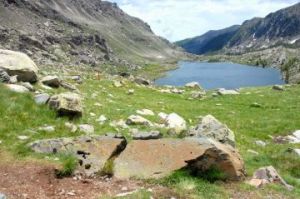
|
 Vallée des Merveilles © T.Joly Vallée des Merveilles © T.Joly

|
A unique world-renowned prehistoric site, the Vallée des Merveilles boasts thousands of Bronze Age rock engravings set amid a stunning rocky landscape dominated by jagged peaks.
[ Practical ]
Getting there
- By road
80 km from Nice on autoroute A8 till exit 59, then on D2204, N204 and D91 till Saint-Dalmas-de-Tende. Or autoroute A8 till Ventimiglia in Italy, then on D6204, N204 and D91 till Saint-Dalmas-de-Tende.
- By public transport
SNCF bus from Nice Saint Roch to Drap-Cantaron, then TER train from Drap-Cantaron to Tende. The journey takes from 2 hours to 2 hours 30 minutes.
Lodging
Chamois d’Or, in Castérino
Les Mélèzes, in Castérino
Le Prieuré, in Saint-Dalmas-de-Tende
Gîte Neige et Merveilles, in La Minière de Vallauria
Refuge des Merveilles, in the Vallée des Merveilles
Restaurants
Chamois d’Or, in Castérino
Les Mélèzes, in Castérino
Musée Départemental des Merveilles
Open from 10am to 5pm, till 6pm from May 2nd to October 15th.
Admission free.
Tel : 0493043250
www.museedesmerveilles.com
Mercantour National Park
www.mercantour.eu
4x4 tours
www.4x4merveilles.com
Information
- Tende tourist office
Tel : 0493047371
www.tendemerveilles.com
- French Riviera tourist office
Tel : 0493377878
www.frenchriviera-tourism.com
In Europe too, prehistoric artists didn’t express their creativity only on cave’s walls. 80 kilometres north of Nice, in the Mercantour National Park, the Vallée des Merveilles and the Vallée de Fontanalbe are home to more than 35,000 rock engravings dating back to the Bronze Age, probably made between 4,000 and 5,000 years ago. The largest concentration of prehistoric works in Europe. A veritable open-air museum, that is also worth seeing for the outstanding surrounding scenery, especially in the Vallée des Merveilles.
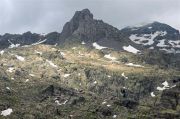
 Vallée des Merveilles © T.Joly Vallée des Merveilles © T.Joly
|
 Glacial valley Glacial valley
These rock engravings are indeed located between 2,100 and 2,500 meters of altitude in a valley whose walls are formed by huge, multi-colored rocks, called chiappes, shaped and polished by the glacier that clawed its way down during the last Ice Age. In addition the valley is dotted with lakes and surrounded by the peaks of L’Arpette, Mont des Merveilles, Grand Capelet and Bégo.
Why did men of the Bronze Age patiently chipped out tens of thousands of pictures on the blood-red and violet surfaces left behind after the glacier melted ?...
No one knows for sure as the valley was apparently never settled. Nestled among rugged mountains, it was too high, and too narrow and rocky for cultivation. Were these engravings contributed over the centuries by pilgrims who climbed here to worship their Gods ?.. Or did tribes living on lower ground make special journeys here to practice religious rites ?...
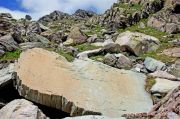
 Vallée des Merveilles © T.Joly Vallée des Merveilles © T.Joly
|
 Known as a cursed place Known as a cursed place
Whatever the answer is, the choice of this valley is probably linked to the 2,872 meters peak dominating its eastern side, the Mount Bégo that is known to attract lightning bolts when alpine storms explode. A fascinating phenomenon that is due to the high levels of zinc and iron in its soil.
Combined with the presence of these mysterious engravings, it explains why a veil of superstition was hung over the place once Christianity became the official religion. As the Church wanted to deter people from this area whose symbols reeked of paganism, several landmarks of the valley were bestowed names with demonic connotations : Devil’s Peak and Pass, Black lake, Carbon lake, Valmasque pass, a name that derives from “masca”, a witch.
So, for centuries only a few shepherds came up here in summer, along with occasional travelers who passed through while traveling between France and Italy. However, known as a cursed place, a periphery of hell, it also attracted magi, astrologers and disciples of Satan.
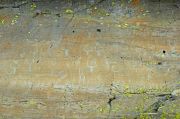
 Vallée des Merveilles © T.Joly Vallée des Merveilles © T.Joly
|
 Horned heads of cattle Horned heads of cattle
Carved on more than 4,000 stones, slabs or boulders, sometimes in association, sometimes alone, these engravings were all executed using quartz tools, by direct percussion on the rock.
Most numerous are the representations of horned heads of cattle, usually portrayed without facial features. Occasionally two such heads are close together, apparently yoked to a plough. The extent to which these animals outnumber any other kind of engraving suggest that the religious beliefs of the visitors of the valley were related to some form of bull-worship.
The second category consists of symbols such as miscellaneous crosses, circles and spirals as well as of oval or rectangular shapes containing subdivided sections. These may represent cultivated fields, sometimes crossed by a path or a stream of water, enclosures in which cattle were kept, nets or traps.
 Anthropomorphic figures Anthropomorphic figures
Weapons, mainly daggers and halberds, form the third main category. Compared with Bronze Age weapons found elsewhere in graves, they gave scientists the clue to dating the whole collection.
Anthropomorphic figures are rare, as in all prehistoric art, and account for less than 1% of the works. Small-sized, they are very schematic and stylized, almost always displayed “in activity,” with arms raised, holding or dragging an object or a weapon. They are striking to look at and known today by such nicknames as “The Dancer”, “The Christ”, “The Chief of the Tribe” and “The Sorcerer”, the latter about 30 cm high looking like making an invocation to the Mount Bégo as the engraving faces the peak.
Lastly, there are also thousands of names, dates, drawings and other kinds of graffiti done by travelers over the centuries with little point and far less skill, the oldest one being from the Roman time and the most numerous from the 19th century.
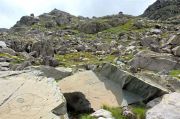
 Vallée des Merveilles © T.Joly Vallée des Merveilles © T.Joly
|
 A steep walk A steep walk
But this incredible open-air museum does not easily reveal its secrets. First, the site is snow-covered for eight months a year and can only be visited June through early October, depending on when the winter snow melts. Then, it’s a bit of a walk to get there. The easiest approach is from the Mesches Lake car park located ten kilometers past Saint-Dalmas-de-Tende, near Casterino where a couple of hotels provide good accommodation. From there, a trail leads to the entrance of the valley, an ascent of about 1,000 meters that is done in 2.5 hours to 3 hours. Shortly after the beginning, it passes by the Minière de Vallauria hamlet where there is a worked-out silver mine, a lake and a gîte. Then it’s a steep walk through a dense larch forest past occasional waterfall and gorges. When you reach a wild, beautiful rock-strewn valley with a clear, swift stream and a carpet of wildflowers, the most difficult is done. The more or less flat trail then leads directly to the Refuge des Merveilles, a small stone building on the shore of a large lake providing basic accommodation, food and information about the valley.
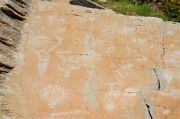
 Vallée des Merveilles © T.Joly Vallée des Merveilles © T.Joly
|
 Must-see museum Must-see museum
Alternatively, It is also possible, to take a four-wheel-drive jeep tour from Saint-Dalmas or Casterino. The price is €85 per person but you have to book well ahead of time to secure a seat.
Nevertheless, you still have to walk a little bit because the engravings are a bit further and higher than the refuge in a narrow valley even wilder than the one below.
To see the most beautiful and famous engravings it’s necessary to join one of the guided tours departing from the refuge. In order to protect these unique pre-historic works from vandalism and looting, people walking alone are indeed forbidden to get off the main trail and can only see a small percentage of the works. Besides, a few of the most beautiful engravings have been replaced in situ by replicas and the originals are now housed in the Musée Départemental des Merveilles of the lovely little Italian-style medieval town of Tende. Dedicated to the natural, archaeological and ethnological history of the upper Roya Valley, that includes the Mount Bégo, it features a large section focusing on the Bronze Age rock engravings of the Vallée des Merveilles.
June 18, 2014
Thierry Joly 

|



